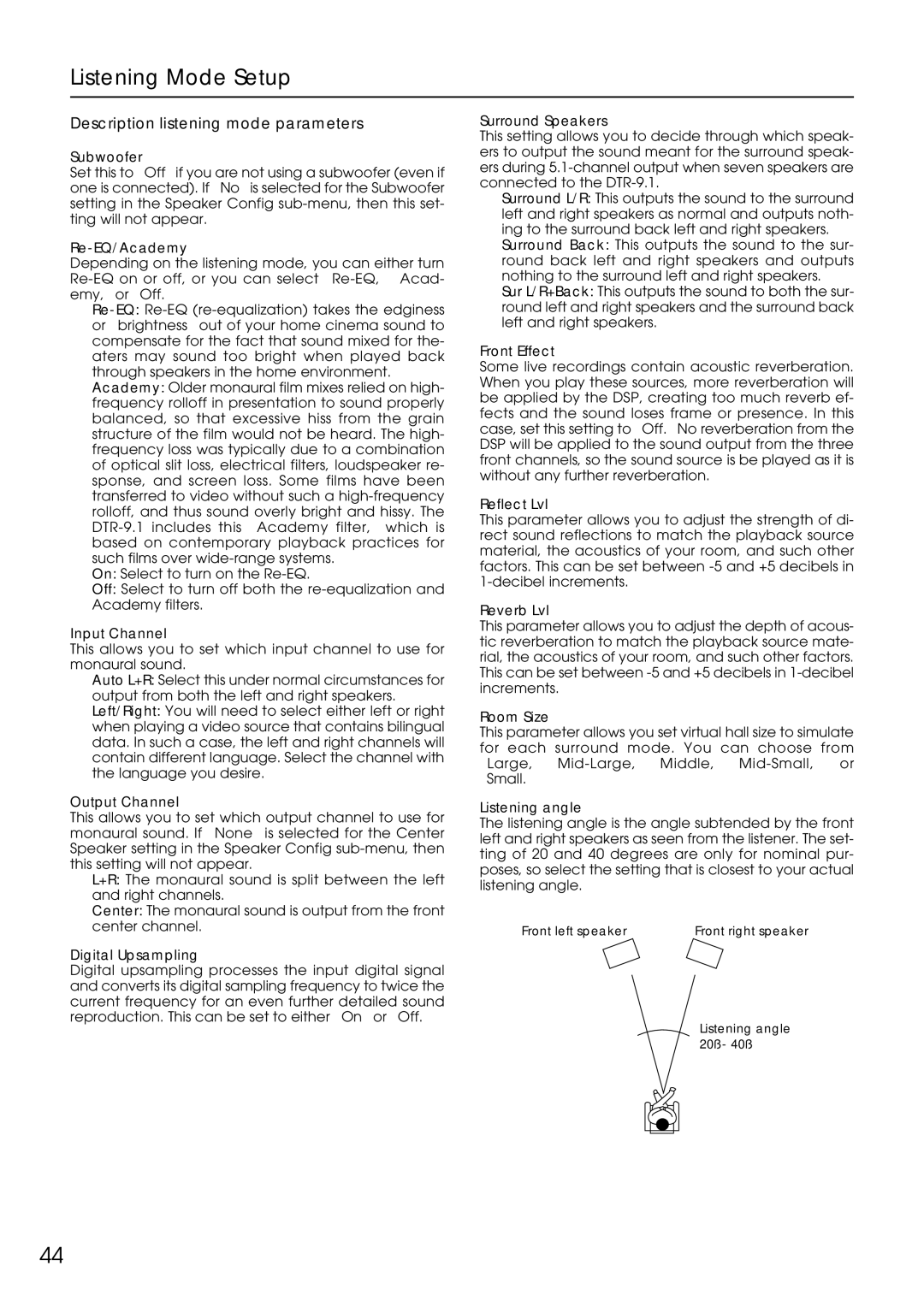DTR-9.1
Important Safeguards
Avis
Precautions
For U.S. model
For Canadian model
Modele pour les Canadien
Contents
Supplied accessories
Contents
THX Ultra
Features
Assignable and Configuaragble 12-Volt Trig
Before using remote controller
Using the remote controller
Front panel facilities
Front panel
Front panel door
Front panel display
Front panel facilities
Tuning
Preset
FM Mode
Off
Remote controller
SEND/LEARN indicator LCD display Power ON/STNBY button
Rear panel facilities
Model NO. DTR-9.1
Rear panel facilities
Coaxial, optical, and input-only AC-3RF
AC Inlet
Video IN/OUT
Example of how to connect your equipment
Video Monitor OUT
Standard connections
Example of how to connect your equipment
Default setting
Connecting your audio components
Connecting a turntable
Connecting an MD recorder, DAT deck, or CD recorder
Connecting a compact disc player
Connecting a LD player
Connecting a video cassette recorder
Connecting a satellite tuner or television
Connecting a television monitor or projector
Connecting speakers
Ideal speaker configuration
Minimum speaker configuration for surround sound playback
Speaker placement
Connecting speakers
Connecting a subwoofer
Assembling the AM loop antenna
Connecting antennas
Connecting the AM loop antenna
Connecting antennas
Connecting an FM outdoor antenna
Connecting an AM outdoor antenna
Directional linkage
Outline
Connecting to the IR in Zone 2 input
Connecting the main and remote zones
Connecting to the IR in Main input
Cabinet
Remove the jumper plugs Connect a graphic equalizer
Connecting a graphic equalizer Connecting power amplifiers
Remove the jumper plugs Connect the power amplifiers
Connecting the power
Turning the power on from the remote controller
Up into six menus Speaker Setup, Input Setup, Listening
On-Screen Display OSD menu
Your home theater, and it rarely needs to be Changed later
OSD menu consists of a main screen that is divided
Press the Menu button
On-Screen Display OSD menu
Navigating through the OSD menu
Speaker Setup
Speaker Config sub-menu
Speaker Setup
Speaker Distance sub-menu
Level Calibration sub-menu
Calibrating the speaker levels
LFE Level Setup sub-menu
Bass Peak Level Bass Peak Level Manager* sub-menu
Input Setup
Digital Setup sub-menu
Input Setup
Multichannel Setup sub-menu
Video Setup sub-menu
Listening Mode Preset sub-menu
DTS Mpeg
Input source signals
Listening Modes
Input Setup
Delay sub-menu Sound Effect sub-menu
123456789012345678901234 4.Preference
Miscellaneous Setup
Character Input sub-menu
Listening Mode Setup
Listening Mode Setup menu
Listening Mode Setup
Description listening mode parameters
THX
Volume Setup sub-menu
Preference
OSD Tweak
OSD Setup sub-menu
Preference
Zone2 OSD Setup
Lock Setup sub-menu
About
Version
Power VOL
Enjoying music or videos in the remote zone
Press the Zone 2 button on the DTR-9.1 Select a source
Input selector buttons
Listening to FM/AM Radio Stations
Preset
Listening to Radio Broadcasts
Press the Enter button again to finalize the procedure
This erases the selected preset station
Listening to Radio Broadcasts
Press the Memory button on the front panel
Changing the listening mode
Selecting an input source Listening with headphones
Adjusting the volume
Using the many features of the DTR-9.1
Enjoying the multichannel output
Enjoying music or videos with the DTR-9.1
If one of the messages shown below appears
Start recording at the recording component as desired
Recording a source
Press the Rec Out button twice within 8 seconds
Recording a source
Using remote controller
Using the remote controller to control each device
Press the AUDIO/TAPE Mode button
Controlling the DTR-9.1
Using remote controller
Listening mode buttons
Press the CD Mode button
Press the MD Mode button
Controlling an Integra CD player
Controlling an Integra MD recorder
Controlling an Integra cassette tape deck
Press the TUN input selector button
Controlling an Integra DVD player
Press the DVD Mode button
SAT, CABLE, VCR, and TV Mode buttons
Programming procedure
Buttons
Page
Erasing the programmed command from one button
Press and release the same Mode button again
SEND/LEARN indicator Mode buttons
You can only erase memorized commands and not preset ones
Using a Macro function
Press the Mode Macro button to complete the programming
Programming a Macro function
Running a Macro function
Using a Macro function
Press the Direct Macro button to complete the procedure
Programming the Direct Macro function
Check to see if the macro has been properly programmed
Press the Mode Macro button again
Press the Direct Macro button again
Erasing all commands and macros that have been programmed
Macro mode programming memo
Press the ENT button
Operation
Troubleshooting guide
Troubleshooting guide
OSD menu settings cannot be changed
Cannot change OSD Menu settings
Late Night function cannot be used
LFE Level function cannot be used
Default settings
Speaker Setup
Input Setup
Zone2 OSD Setup
Your system setting
Inputs
Your system setting
Tape
OSD Setup
Speakers
Remote controller
Mode
Specifications
Other upgraded function
Upgraded-2
Speaker configuration and placement/ Connecting speakers
Important points regarding speaker placement
Crossover80HzTHX QuitOSD
Boundary Gain
Digital Setup sub-menu Listening Mode Preset sub-menu
Channel digital surround format
Relationship between input source and listening mode
Upgraded-8
THX
When Upsampling is set to On, DTS Neo6 cannot be selected
DTS-ES
Upgraded-12
DTS-ES
Upgraded-14
Parameter
Other upgraded function
Delay sub-menu

